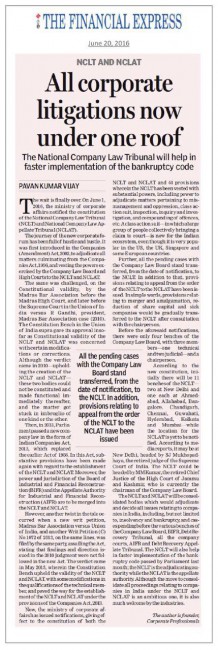
By: Pavan Kumar Vijay
The wait is finally over. On June 1, 2016, the ministry of corporate affairs notified the constitution of the National Company Law Tribunal (NCLT) and National Company Law Appellate Tribunal (NCLAT).
The journey of the new corporate forum has been full of hustle and bustle. It was first introduced in the Companies (Amendment) Act, 2002, to adjudicate all matters culminating from the Companies Act, 1956, and vesting the powers exercised by the Company Law Board and High Courts to the NCLT and NCLAT.
The same was challenged, on the Constitutional validity, by the Madras Bar Association before the Madras High Court, and later before the Supreme Court in the Union of India versus R Gandhi, president, Madras Bar Association case (2010). The Constitution Bench in the Union of India supra gave its approval insofar as Constitutional validity of the NCLT and NCLAT was concerned with certain modifications or corrections. Although the verdict came in 2010—upholding the creation of the NCLT and NCLAT—these two bodies could not be constituted and made functional immediately thereafter, and the matter got stuck in imbroglio of one kind or the other.
Then, in 2013, Parliament passed a new company law in the form of Indian Companies Act, 2013, which replaced the earlier Act of 1956. In this Act, substantive provisions have been made again with regard to the establishment of the NCLT and NCLAT. Moreover, the power and jurisdiction of the Board of Industrial and Financial Reconstruction (BIFR) and the Appellate Authority for Industrial and Financial Reconstruction (AIFR) are to be merged into the NCLT and NCLAT.
However, another twist in the tale occurred when a new writ petition, Madras Bar Association versus Union of India, and another Writ Petition (C) No 1072 of 2013, on the same lines, was filed by the same party, assailing the Act, stating that findings and direction issued in the 2010 judgment were not followed in the new Act. The verdict came in May 2015, wherein the Constitution Bench upheld the validity of the NCLT and NCLAT, with some modifications in the qualifications of the technical member, and paved the way for the establishment of the NCLT and NCLAT under the provisions of the Companies Act, 2013.
Now, the ministry of corporate affairs has issued notifications, giving effect to the constitution of both the NCLT and NCLAT and 44 provisions wherein the NCLT has been vested with substantial powers, including power to adjudicate matters pertaining to mismanagement and oppression, class action suit, inspection, inquiry and investigation, and compounding of offences, etc. A class action suit—in which a large group of people collectively bringing a claim to court—is new for the Indian ecosystem, even though it is very popular in the US, the UK, Singapore and some European countries.
Further, all the pending cases with the Company Law Board stand transferred, from the date of notification, to the NCLT. In addition to that, provisions relating to appeal from the order of the NCLT to the NCLAT have been issued. In simple words, provisions relating to merger and amalgamation, reduction of share capital and sick companies would be gradually transferred to the NCLT after consultation with the chairperson.
Before the aforesaid notifications, there were only four benches of the Company Law Board, with three members—one technical and two judicial—and a chairperson.
According to the new constitution, initially there will be 11 benches of the NCLT—two at New Delhi and one each at Ahmedabad, Allahabad, Bangalore, Chandigarh, Chennai, Guwahati, Hyderabad, Kolkata and Mumbai—while the location for the NCLAT is yet to be notified. According to media reports, it may be at New Delhi, headed by SJ Mukhopadhaya, the retired judge of the Supreme Court of India. The NCLT could be headed by MM Kumar, the retired Chief Justice of the High Court of Jammu and Kashmir, who is currently the chairman of the Company Law Board.
The NCLT and NCLAT will be consolidated bodies which would adjudicate and decide all issues relating to companies in India, including, but not limited to, insolvency and bankruptcy, and cases pending before the various benches of the Company Law Board, BIFR, Debt Recovery Tribunal, all the company courts, AIFR and Debt Recovery Appellate Tribunal. The NCLT will also help in faster implementation of the bankruptcy code passed by Parliament last month; the NCLT is the adjudicating authority while the NCLAT is the appellate authority. Although the move to consolidate all proceedings relating to companies in India under the NCLT and NCLAT is an ambitious one, it is also much welcome by the industries.
The author is founder, Corporate Professionals
